Case Study: Wireless Sensor Networks in Agriculture - MITS5003
VerifiedAdded on 2023/01/13
|11
|2450
|33
Case Study
AI Summary
This case study analyzes the implementation of a Wireless Sensor Network (WSN) in a livestock farm, MaffraStock. The solution explores several key aspects of WSN design and performance, including selecting a suitable frequency band (2.4 GHz) and calculating the channel capacity for different communication scenarios. It delves into noise analysis, specifically thermal and total noise experienced within the network. The document further addresses signal power calculations, bandwidth determination, and the impact of Frequency Division Multiplexing (FDM) on channel bandwidth. It also calculates the maximum free space loss experienced by signals and determines the required transmission signal strength considering signal impairments. Finally, the case study explores the potential of cloud applications and IoT platforms to effectively manage and utilize the sensor data for agricultural applications. The solution demonstrates the application of formulas and principles related to wireless communication, signal propagation, and network design within the context of a real-world agricultural scenario.
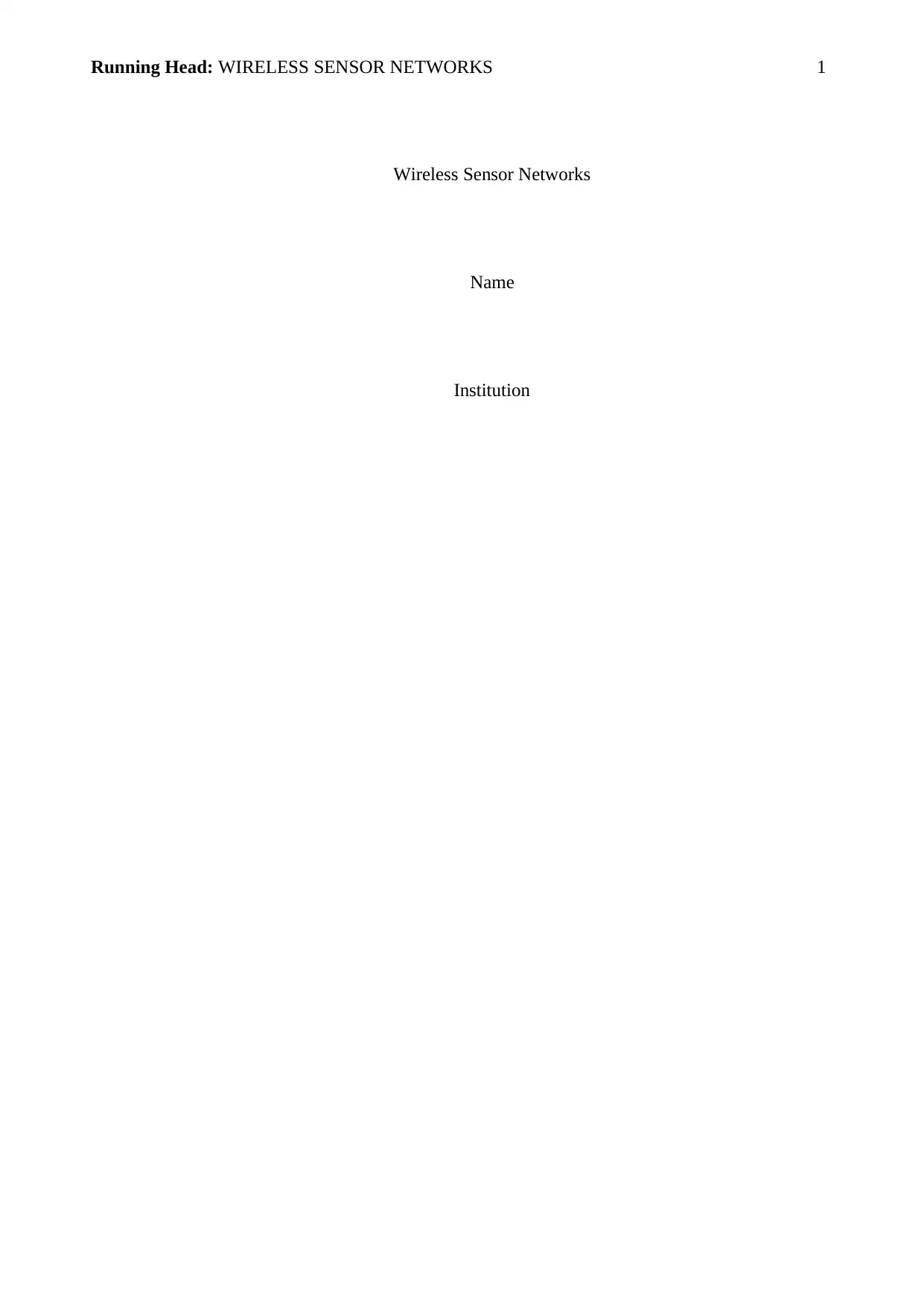
Running Head: WIRELESS SENSOR NETWORKS 1
Wireless Sensor Networks
Name
Institution
Wireless Sensor Networks
Name
Institution
Paraphrase This Document
Need a fresh take? Get an instant paraphrase of this document with our AI Paraphraser
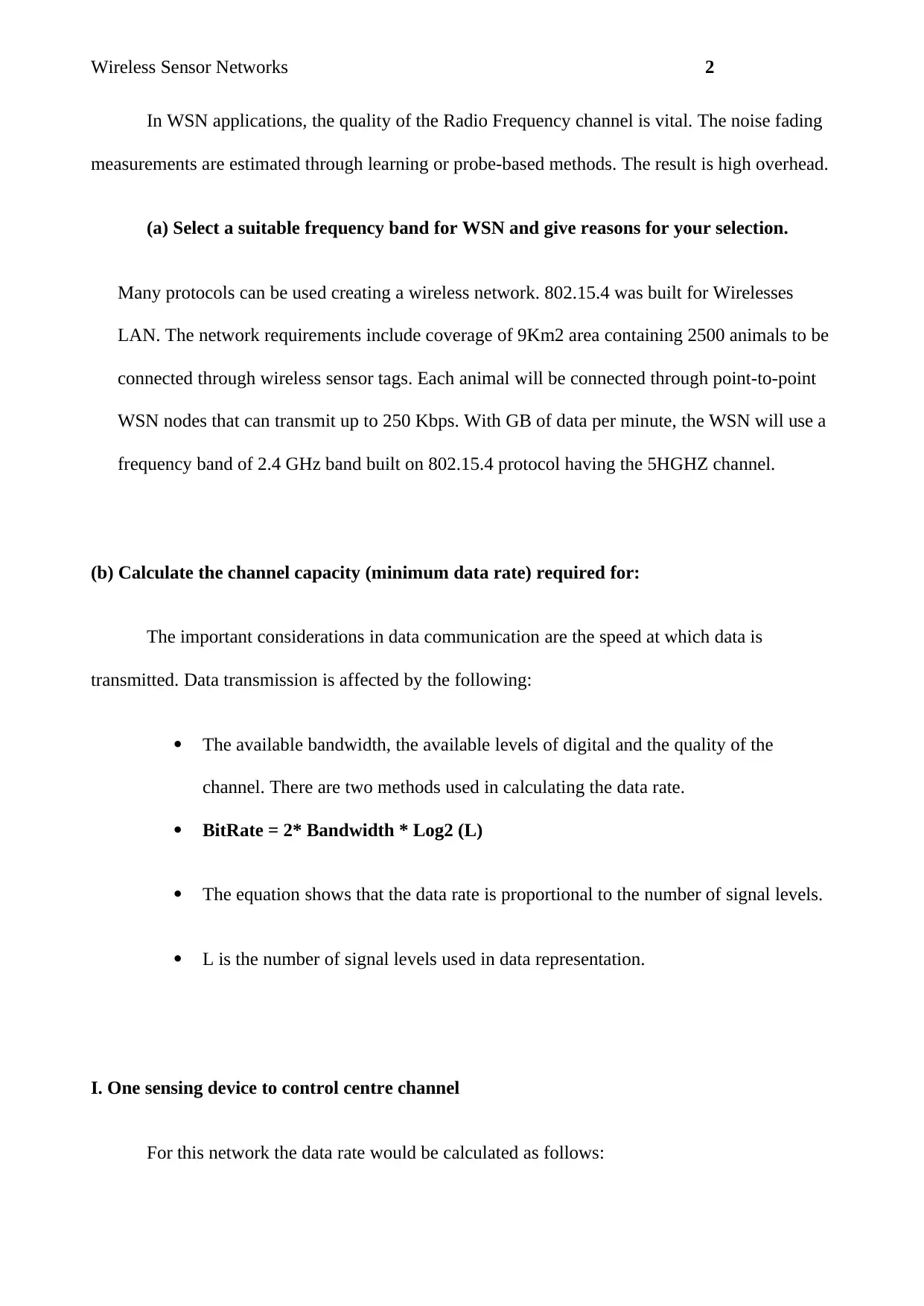
Wireless Sensor Networks 2
In WSN applications, the quality of the Radio Frequency channel is vital. The noise fading
measurements are estimated through learning or probe-based methods. The result is high overhead.
(a) Select a suitable frequency band for WSN and give reasons for your selection.
Many protocols can be used creating a wireless network. 802.15.4 was built for Wirelesses
LAN. The network requirements include coverage of 9Km2 area containing 2500 animals to be
connected through wireless sensor tags. Each animal will be connected through point-to-point
WSN nodes that can transmit up to 250 Kbps. With GB of data per minute, the WSN will use a
frequency band of 2.4 GHz band built on 802.15.4 protocol having the 5HGHZ channel.
(b) Calculate the channel capacity (minimum data rate) required for:
The important considerations in data communication are the speed at which data is
transmitted. Data transmission is affected by the following:
The available bandwidth, the available levels of digital and the quality of the
channel. There are two methods used in calculating the data rate.
BitRate = 2* Bandwidth * Log2 (L)
The equation shows that the data rate is proportional to the number of signal levels.
L is the number of signal levels used in data representation.
I. One sensing device to control centre channel
For this network the data rate would be calculated as follows:
In WSN applications, the quality of the Radio Frequency channel is vital. The noise fading
measurements are estimated through learning or probe-based methods. The result is high overhead.
(a) Select a suitable frequency band for WSN and give reasons for your selection.
Many protocols can be used creating a wireless network. 802.15.4 was built for Wirelesses
LAN. The network requirements include coverage of 9Km2 area containing 2500 animals to be
connected through wireless sensor tags. Each animal will be connected through point-to-point
WSN nodes that can transmit up to 250 Kbps. With GB of data per minute, the WSN will use a
frequency band of 2.4 GHz band built on 802.15.4 protocol having the 5HGHZ channel.
(b) Calculate the channel capacity (minimum data rate) required for:
The important considerations in data communication are the speed at which data is
transmitted. Data transmission is affected by the following:
The available bandwidth, the available levels of digital and the quality of the
channel. There are two methods used in calculating the data rate.
BitRate = 2* Bandwidth * Log2 (L)
The equation shows that the data rate is proportional to the number of signal levels.
L is the number of signal levels used in data representation.
I. One sensing device to control centre channel
For this network the data rate would be calculated as follows:
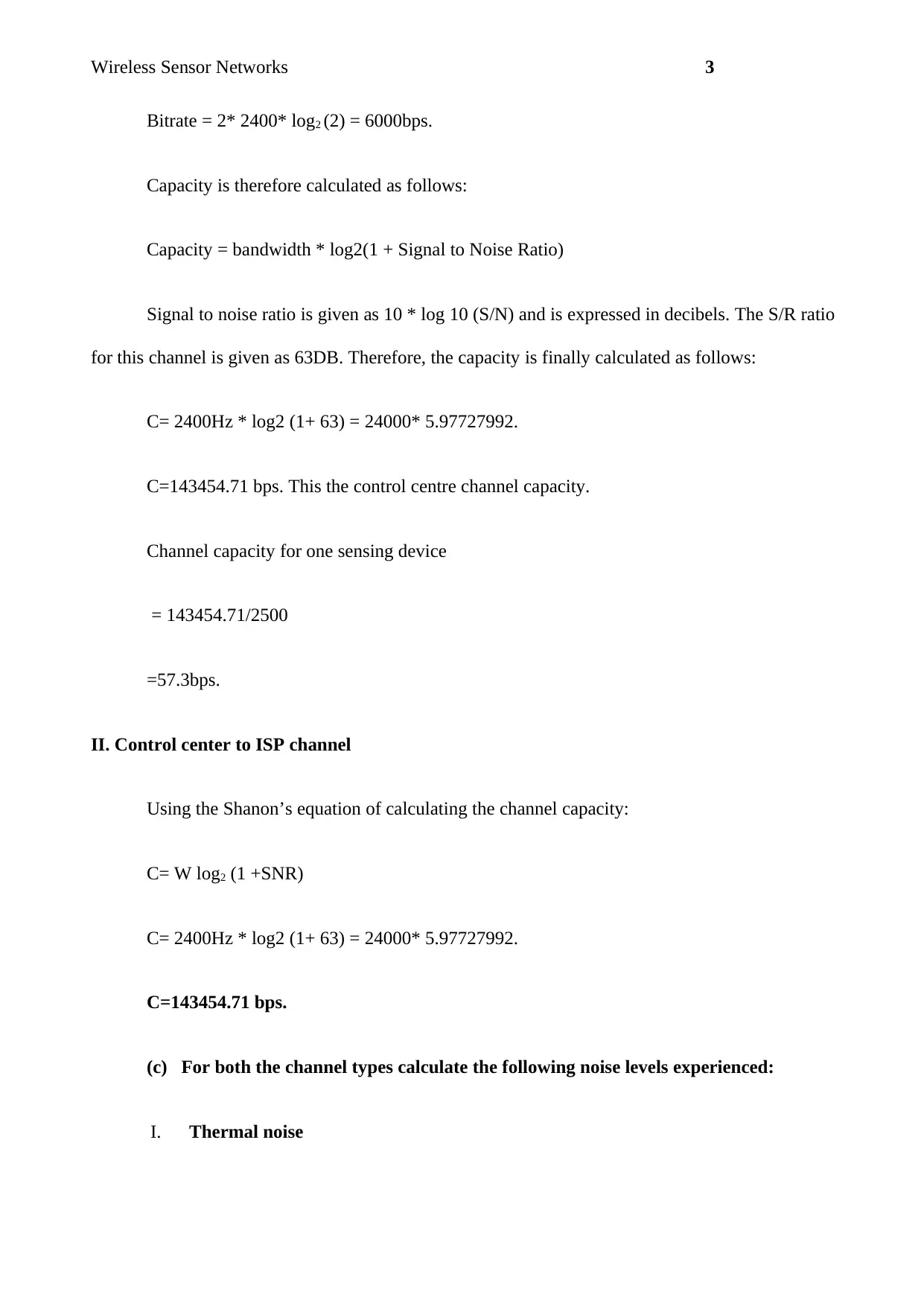
Wireless Sensor Networks 3
Bitrate = 2* 2400* log2 (2) = 6000bps.
Capacity is therefore calculated as follows:
Capacity = bandwidth * log2(1 + Signal to Noise Ratio)
Signal to noise ratio is given as 10 * log 10 (S/N) and is expressed in decibels. The S/R ratio
for this channel is given as 63DB. Therefore, the capacity is finally calculated as follows:
C= 2400Hz * log2 (1+ 63) = 24000* 5.97727992.
C=143454.71 bps. This the control centre channel capacity.
Channel capacity for one sensing device
= 143454.71/2500
=57.3bps.
II. Control center to ISP channel
Using the Shanon’s equation of calculating the channel capacity:
C= W log2 (1 +SNR)
C= 2400Hz * log2 (1+ 63) = 24000* 5.97727992.
C=143454.71 bps.
(c) For both the channel types calculate the following noise levels experienced:
I. Thermal noise
Bitrate = 2* 2400* log2 (2) = 6000bps.
Capacity is therefore calculated as follows:
Capacity = bandwidth * log2(1 + Signal to Noise Ratio)
Signal to noise ratio is given as 10 * log 10 (S/N) and is expressed in decibels. The S/R ratio
for this channel is given as 63DB. Therefore, the capacity is finally calculated as follows:
C= 2400Hz * log2 (1+ 63) = 24000* 5.97727992.
C=143454.71 bps. This the control centre channel capacity.
Channel capacity for one sensing device
= 143454.71/2500
=57.3bps.
II. Control center to ISP channel
Using the Shanon’s equation of calculating the channel capacity:
C= W log2 (1 +SNR)
C= 2400Hz * log2 (1+ 63) = 24000* 5.97727992.
C=143454.71 bps.
(c) For both the channel types calculate the following noise levels experienced:
I. Thermal noise
⊘ This is a preview!⊘
Do you want full access?
Subscribe today to unlock all pages.

Trusted by 1+ million students worldwide
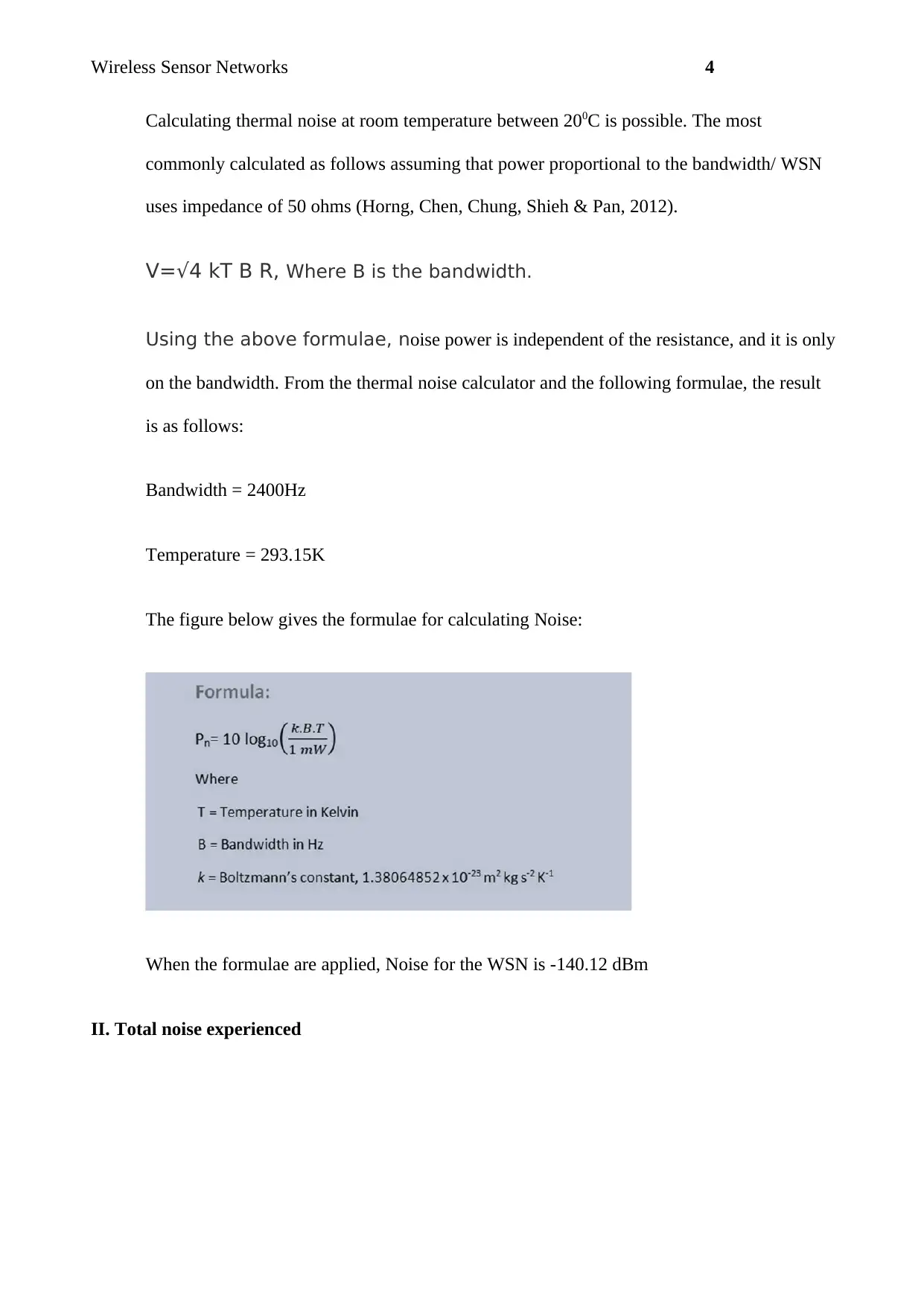
Wireless Sensor Networks 4
Calculating thermal noise at room temperature between 200C is possible. The most
commonly calculated as follows assuming that power proportional to the bandwidth/ WSN
uses impedance of 50 ohms (Horng, Chen, Chung, Shieh & Pan, 2012).
V=√4 kT B R, Where B is the bandwidth.
Using the above formulae, noise power is independent of the resistance, and it is only
on the bandwidth. From the thermal noise calculator and the following formulae, the result
is as follows:
Bandwidth = 2400Hz
Temperature = 293.15K
The figure below gives the formulae for calculating Noise:
When the formulae are applied, Noise for the WSN is -140.12 dBm
II. Total noise experienced
Calculating thermal noise at room temperature between 200C is possible. The most
commonly calculated as follows assuming that power proportional to the bandwidth/ WSN
uses impedance of 50 ohms (Horng, Chen, Chung, Shieh & Pan, 2012).
V=√4 kT B R, Where B is the bandwidth.
Using the above formulae, noise power is independent of the resistance, and it is only
on the bandwidth. From the thermal noise calculator and the following formulae, the result
is as follows:
Bandwidth = 2400Hz
Temperature = 293.15K
The figure below gives the formulae for calculating Noise:
When the formulae are applied, Noise for the WSN is -140.12 dBm
II. Total noise experienced
Paraphrase This Document
Need a fresh take? Get an instant paraphrase of this document with our AI Paraphraser
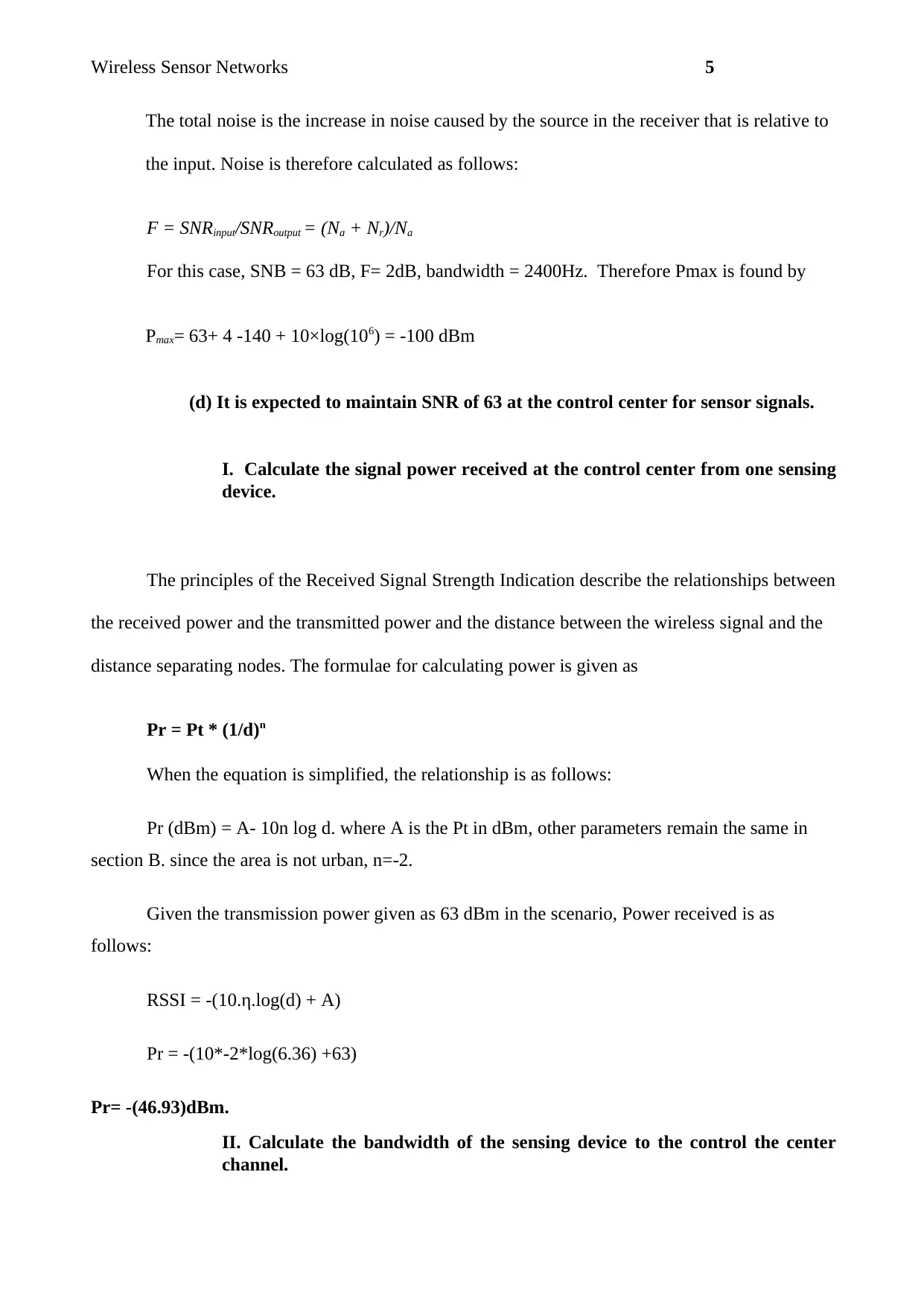
Wireless Sensor Networks 5
The total noise is the increase in noise caused by the source in the receiver that is relative to
the input. Noise is therefore calculated as follows:
F = SNRinput/SNRoutput = (Na + Nr)/Na
For this case, SNB = 63 dB, F= 2dB, bandwidth = 2400Hz. Therefore Pmax is found by
Pmax= 63+ 4 -140 + 10×log(106) = -100 dBm
(d) It is expected to maintain SNR of 63 at the control center for sensor signals.
I. Calculate the signal power received at the control center from one sensing
device.
The principles of the Received Signal Strength Indication describe the relationships between
the received power and the transmitted power and the distance between the wireless signal and the
distance separating nodes. The formulae for calculating power is given as
Pr = Pt * (1/d)n
When the equation is simplified, the relationship is as follows:
Pr (dBm) = A- 10n log d. where A is the Pt in dBm, other parameters remain the same in
section B. since the area is not urban, n=-2.
Given the transmission power given as 63 dBm in the scenario, Power received is as
follows:
RSSI = -(10.η.log(d) + A)
Pr = -(10*-2*log(6.36) +63)
Pr= -(46.93)dBm.
II. Calculate the bandwidth of the sensing device to the control the center
channel.
The total noise is the increase in noise caused by the source in the receiver that is relative to
the input. Noise is therefore calculated as follows:
F = SNRinput/SNRoutput = (Na + Nr)/Na
For this case, SNB = 63 dB, F= 2dB, bandwidth = 2400Hz. Therefore Pmax is found by
Pmax= 63+ 4 -140 + 10×log(106) = -100 dBm
(d) It is expected to maintain SNR of 63 at the control center for sensor signals.
I. Calculate the signal power received at the control center from one sensing
device.
The principles of the Received Signal Strength Indication describe the relationships between
the received power and the transmitted power and the distance between the wireless signal and the
distance separating nodes. The formulae for calculating power is given as
Pr = Pt * (1/d)n
When the equation is simplified, the relationship is as follows:
Pr (dBm) = A- 10n log d. where A is the Pt in dBm, other parameters remain the same in
section B. since the area is not urban, n=-2.
Given the transmission power given as 63 dBm in the scenario, Power received is as
follows:
RSSI = -(10.η.log(d) + A)
Pr = -(10*-2*log(6.36) +63)
Pr= -(46.93)dBm.
II. Calculate the bandwidth of the sensing device to the control the center
channel.
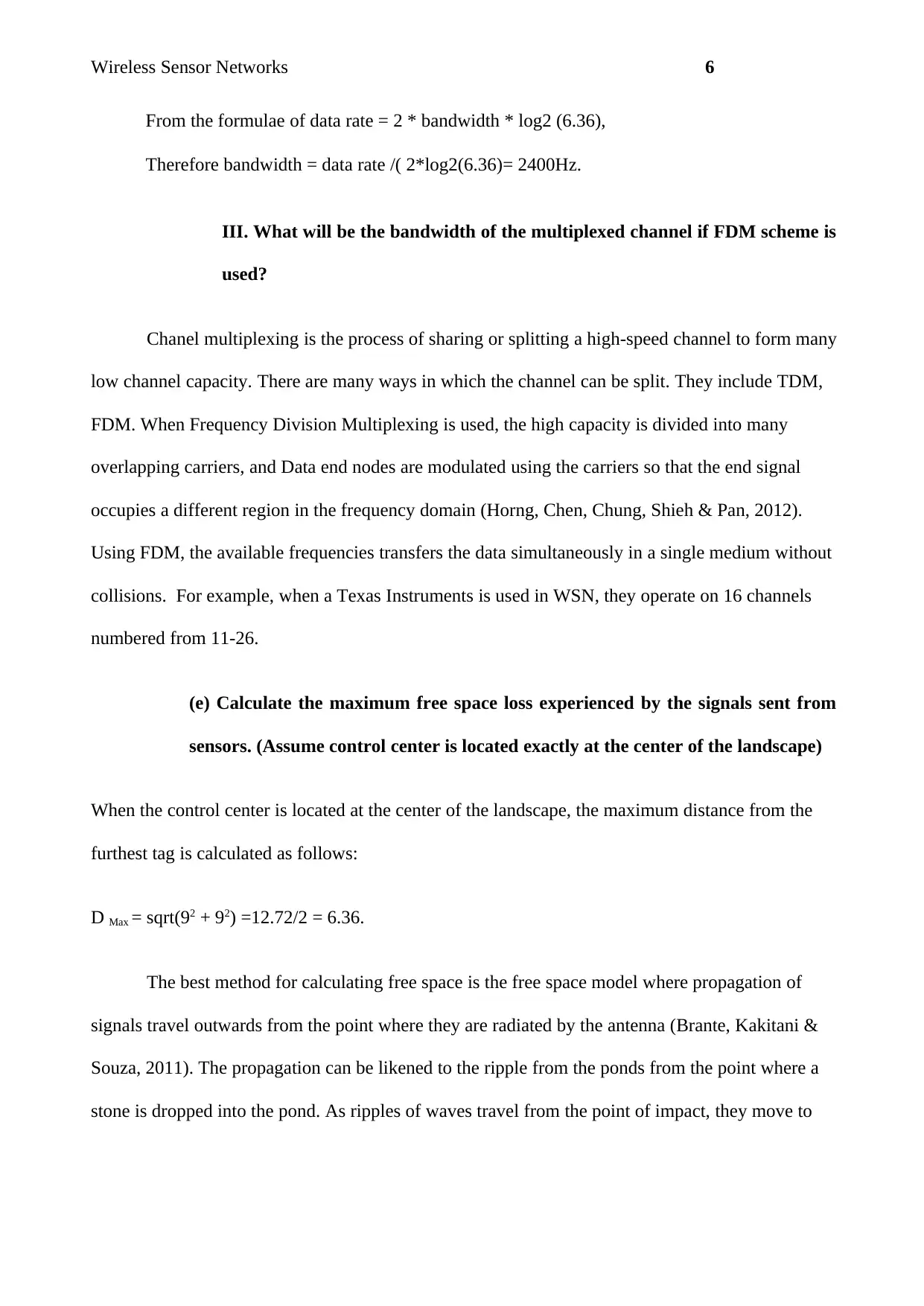
Wireless Sensor Networks 6
From the formulae of data rate = 2 * bandwidth * log2 (6.36),
Therefore bandwidth = data rate /( 2*log2(6.36)= 2400Hz.
III. What will be the bandwidth of the multiplexed channel if FDM scheme is
used?
Chanel multiplexing is the process of sharing or splitting a high-speed channel to form many
low channel capacity. There are many ways in which the channel can be split. They include TDM,
FDM. When Frequency Division Multiplexing is used, the high capacity is divided into many
overlapping carriers, and Data end nodes are modulated using the carriers so that the end signal
occupies a different region in the frequency domain (Horng, Chen, Chung, Shieh & Pan, 2012).
Using FDM, the available frequencies transfers the data simultaneously in a single medium without
collisions. For example, when a Texas Instruments is used in WSN, they operate on 16 channels
numbered from 11-26.
(e) Calculate the maximum free space loss experienced by the signals sent from
sensors. (Assume control center is located exactly at the center of the landscape)
When the control center is located at the center of the landscape, the maximum distance from the
furthest tag is calculated as follows:
D Max = sqrt(92 + 92) =12.72/2 = 6.36.
The best method for calculating free space is the free space model where propagation of
signals travel outwards from the point where they are radiated by the antenna (Brante, Kakitani &
Souza, 2011). The propagation can be likened to the ripple from the ponds from the point where a
stone is dropped into the pond. As ripples of waves travel from the point of impact, they move to
From the formulae of data rate = 2 * bandwidth * log2 (6.36),
Therefore bandwidth = data rate /( 2*log2(6.36)= 2400Hz.
III. What will be the bandwidth of the multiplexed channel if FDM scheme is
used?
Chanel multiplexing is the process of sharing or splitting a high-speed channel to form many
low channel capacity. There are many ways in which the channel can be split. They include TDM,
FDM. When Frequency Division Multiplexing is used, the high capacity is divided into many
overlapping carriers, and Data end nodes are modulated using the carriers so that the end signal
occupies a different region in the frequency domain (Horng, Chen, Chung, Shieh & Pan, 2012).
Using FDM, the available frequencies transfers the data simultaneously in a single medium without
collisions. For example, when a Texas Instruments is used in WSN, they operate on 16 channels
numbered from 11-26.
(e) Calculate the maximum free space loss experienced by the signals sent from
sensors. (Assume control center is located exactly at the center of the landscape)
When the control center is located at the center of the landscape, the maximum distance from the
furthest tag is calculated as follows:
D Max = sqrt(92 + 92) =12.72/2 = 6.36.
The best method for calculating free space is the free space model where propagation of
signals travel outwards from the point where they are radiated by the antenna (Brante, Kakitani &
Souza, 2011). The propagation can be likened to the ripple from the ponds from the point where a
stone is dropped into the pond. As ripples of waves travel from the point of impact, they move to
⊘ This is a preview!⊘
Do you want full access?
Subscribe today to unlock all pages.

Trusted by 1+ million students worldwide
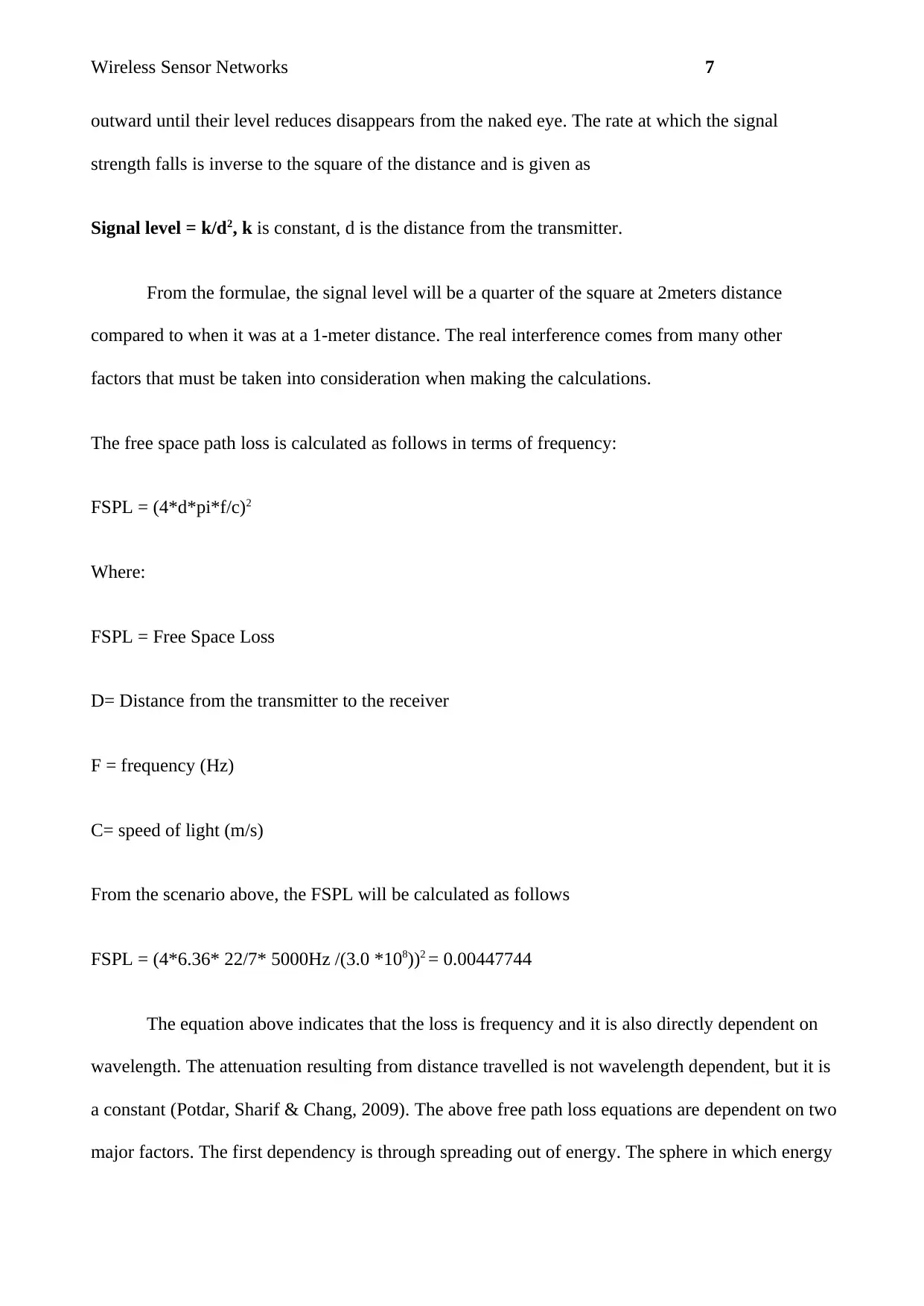
Wireless Sensor Networks 7
outward until their level reduces disappears from the naked eye. The rate at which the signal
strength falls is inverse to the square of the distance and is given as
Signal level = k/d2, k is constant, d is the distance from the transmitter.
From the formulae, the signal level will be a quarter of the square at 2meters distance
compared to when it was at a 1-meter distance. The real interference comes from many other
factors that must be taken into consideration when making the calculations.
The free space path loss is calculated as follows in terms of frequency:
FSPL = (4*d*pi*f/c)2
Where:
FSPL = Free Space Loss
D= Distance from the transmitter to the receiver
F = frequency (Hz)
C= speed of light (m/s)
From the scenario above, the FSPL will be calculated as follows
FSPL = (4*6.36* 22/7* 5000Hz /(3.0 *108))2 = 0.00447744
The equation above indicates that the loss is frequency and it is also directly dependent on
wavelength. The attenuation resulting from distance travelled is not wavelength dependent, but it is
a constant (Potdar, Sharif & Chang, 2009). The above free path loss equations are dependent on two
major factors. The first dependency is through spreading out of energy. The sphere in which energy
outward until their level reduces disappears from the naked eye. The rate at which the signal
strength falls is inverse to the square of the distance and is given as
Signal level = k/d2, k is constant, d is the distance from the transmitter.
From the formulae, the signal level will be a quarter of the square at 2meters distance
compared to when it was at a 1-meter distance. The real interference comes from many other
factors that must be taken into consideration when making the calculations.
The free space path loss is calculated as follows in terms of frequency:
FSPL = (4*d*pi*f/c)2
Where:
FSPL = Free Space Loss
D= Distance from the transmitter to the receiver
F = frequency (Hz)
C= speed of light (m/s)
From the scenario above, the FSPL will be calculated as follows
FSPL = (4*6.36* 22/7* 5000Hz /(3.0 *108))2 = 0.00447744
The equation above indicates that the loss is frequency and it is also directly dependent on
wavelength. The attenuation resulting from distance travelled is not wavelength dependent, but it is
a constant (Potdar, Sharif & Chang, 2009). The above free path loss equations are dependent on two
major factors. The first dependency is through spreading out of energy. The sphere in which energy
Paraphrase This Document
Need a fresh take? Get an instant paraphrase of this document with our AI Paraphraser
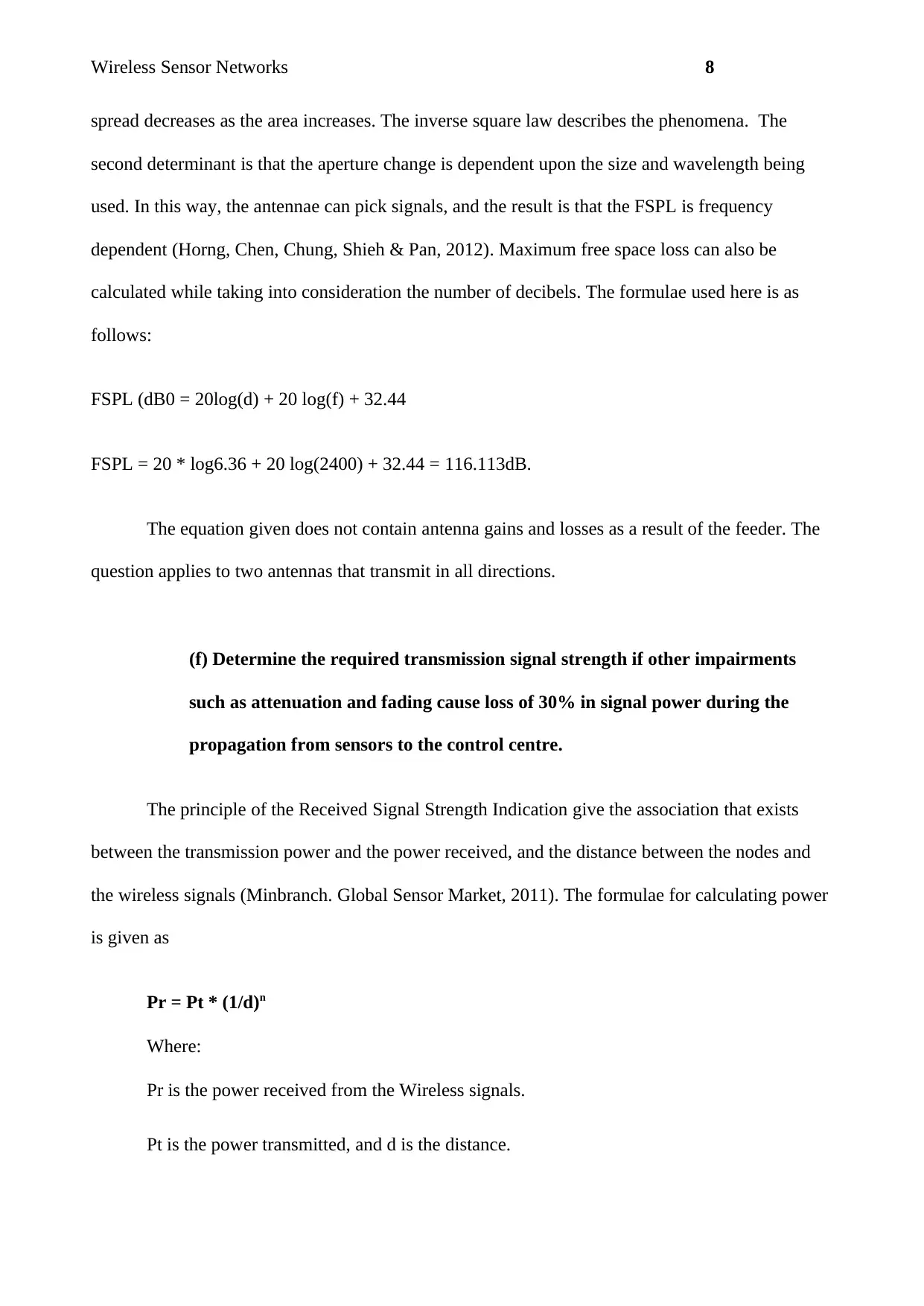
Wireless Sensor Networks 8
spread decreases as the area increases. The inverse square law describes the phenomena. The
second determinant is that the aperture change is dependent upon the size and wavelength being
used. In this way, the antennae can pick signals, and the result is that the FSPL is frequency
dependent (Horng, Chen, Chung, Shieh & Pan, 2012). Maximum free space loss can also be
calculated while taking into consideration the number of decibels. The formulae used here is as
follows:
FSPL (dB0 = 20log(d) + 20 log(f) + 32.44
FSPL = 20 * log6.36 + 20 log(2400) + 32.44 = 116.113dB.
The equation given does not contain antenna gains and losses as a result of the feeder. The
question applies to two antennas that transmit in all directions.
(f) Determine the required transmission signal strength if other impairments
such as attenuation and fading cause loss of 30% in signal power during the
propagation from sensors to the control centre.
The principle of the Received Signal Strength Indication give the association that exists
between the transmission power and the power received, and the distance between the nodes and
the wireless signals (Minbranch. Global Sensor Market, 2011). The formulae for calculating power
is given as
Pr = Pt * (1/d)n
Where:
Pr is the power received from the Wireless signals.
Pt is the power transmitted, and d is the distance.
spread decreases as the area increases. The inverse square law describes the phenomena. The
second determinant is that the aperture change is dependent upon the size and wavelength being
used. In this way, the antennae can pick signals, and the result is that the FSPL is frequency
dependent (Horng, Chen, Chung, Shieh & Pan, 2012). Maximum free space loss can also be
calculated while taking into consideration the number of decibels. The formulae used here is as
follows:
FSPL (dB0 = 20log(d) + 20 log(f) + 32.44
FSPL = 20 * log6.36 + 20 log(2400) + 32.44 = 116.113dB.
The equation given does not contain antenna gains and losses as a result of the feeder. The
question applies to two antennas that transmit in all directions.
(f) Determine the required transmission signal strength if other impairments
such as attenuation and fading cause loss of 30% in signal power during the
propagation from sensors to the control centre.
The principle of the Received Signal Strength Indication give the association that exists
between the transmission power and the power received, and the distance between the nodes and
the wireless signals (Minbranch. Global Sensor Market, 2011). The formulae for calculating power
is given as
Pr = Pt * (1/d)n
Where:
Pr is the power received from the Wireless signals.
Pt is the power transmitted, and d is the distance.
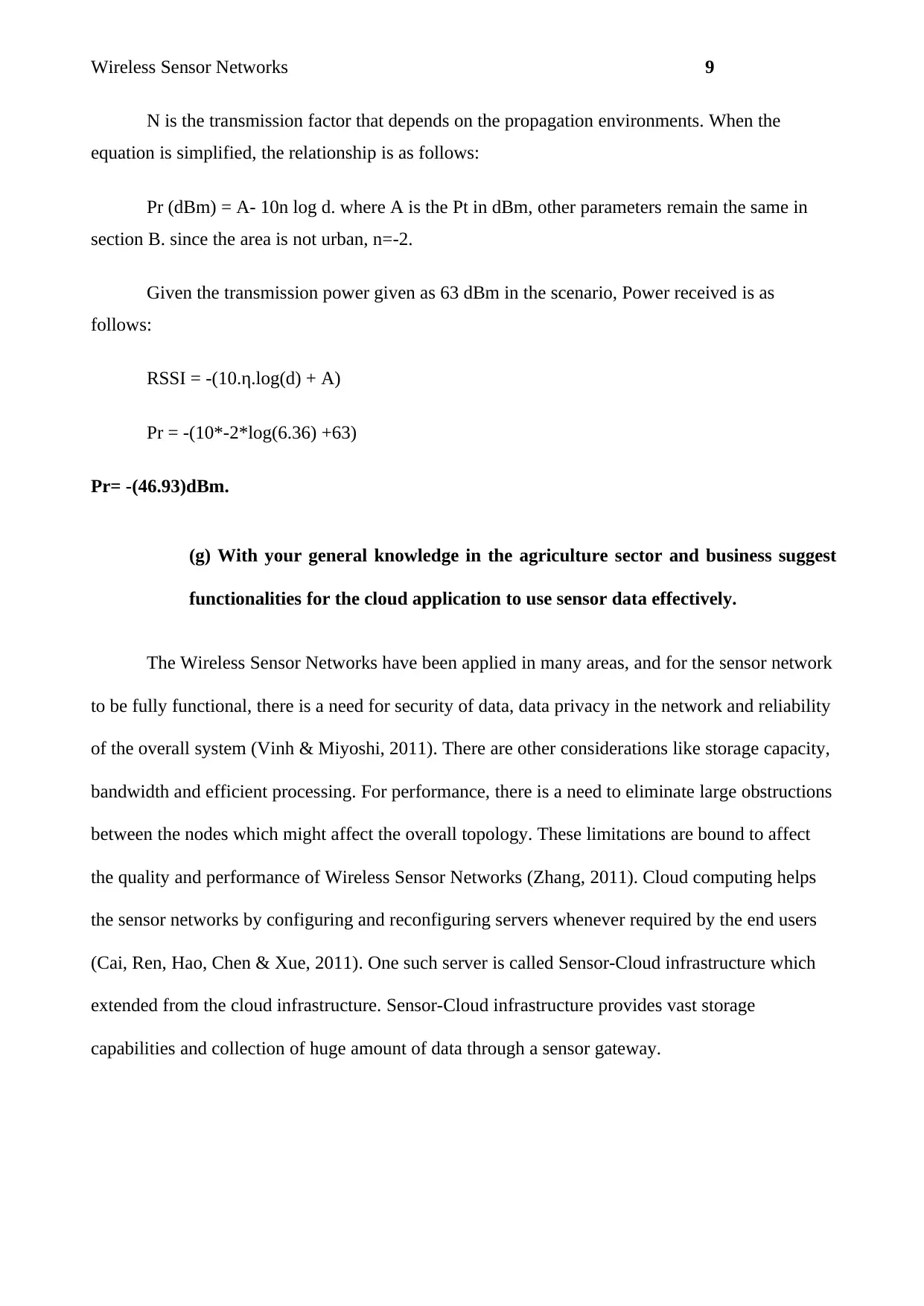
Wireless Sensor Networks 9
N is the transmission factor that depends on the propagation environments. When the
equation is simplified, the relationship is as follows:
Pr (dBm) = A- 10n log d. where A is the Pt in dBm, other parameters remain the same in
section B. since the area is not urban, n=-2.
Given the transmission power given as 63 dBm in the scenario, Power received is as
follows:
RSSI = -(10.η.log(d) + A)
Pr = -(10*-2*log(6.36) +63)
Pr= -(46.93)dBm.
(g) With your general knowledge in the agriculture sector and business suggest
functionalities for the cloud application to use sensor data effectively.
The Wireless Sensor Networks have been applied in many areas, and for the sensor network
to be fully functional, there is a need for security of data, data privacy in the network and reliability
of the overall system (Vinh & Miyoshi, 2011). There are other considerations like storage capacity,
bandwidth and efficient processing. For performance, there is a need to eliminate large obstructions
between the nodes which might affect the overall topology. These limitations are bound to affect
the quality and performance of Wireless Sensor Networks (Zhang, 2011). Cloud computing helps
the sensor networks by configuring and reconfiguring servers whenever required by the end users
(Cai, Ren, Hao, Chen & Xue, 2011). One such server is called Sensor-Cloud infrastructure which
extended from the cloud infrastructure. Sensor-Cloud infrastructure provides vast storage
capabilities and collection of huge amount of data through a sensor gateway.
N is the transmission factor that depends on the propagation environments. When the
equation is simplified, the relationship is as follows:
Pr (dBm) = A- 10n log d. where A is the Pt in dBm, other parameters remain the same in
section B. since the area is not urban, n=-2.
Given the transmission power given as 63 dBm in the scenario, Power received is as
follows:
RSSI = -(10.η.log(d) + A)
Pr = -(10*-2*log(6.36) +63)
Pr= -(46.93)dBm.
(g) With your general knowledge in the agriculture sector and business suggest
functionalities for the cloud application to use sensor data effectively.
The Wireless Sensor Networks have been applied in many areas, and for the sensor network
to be fully functional, there is a need for security of data, data privacy in the network and reliability
of the overall system (Vinh & Miyoshi, 2011). There are other considerations like storage capacity,
bandwidth and efficient processing. For performance, there is a need to eliminate large obstructions
between the nodes which might affect the overall topology. These limitations are bound to affect
the quality and performance of Wireless Sensor Networks (Zhang, 2011). Cloud computing helps
the sensor networks by configuring and reconfiguring servers whenever required by the end users
(Cai, Ren, Hao, Chen & Xue, 2011). One such server is called Sensor-Cloud infrastructure which
extended from the cloud infrastructure. Sensor-Cloud infrastructure provides vast storage
capabilities and collection of huge amount of data through a sensor gateway.
⊘ This is a preview!⊘
Do you want full access?
Subscribe today to unlock all pages.

Trusted by 1+ million students worldwide
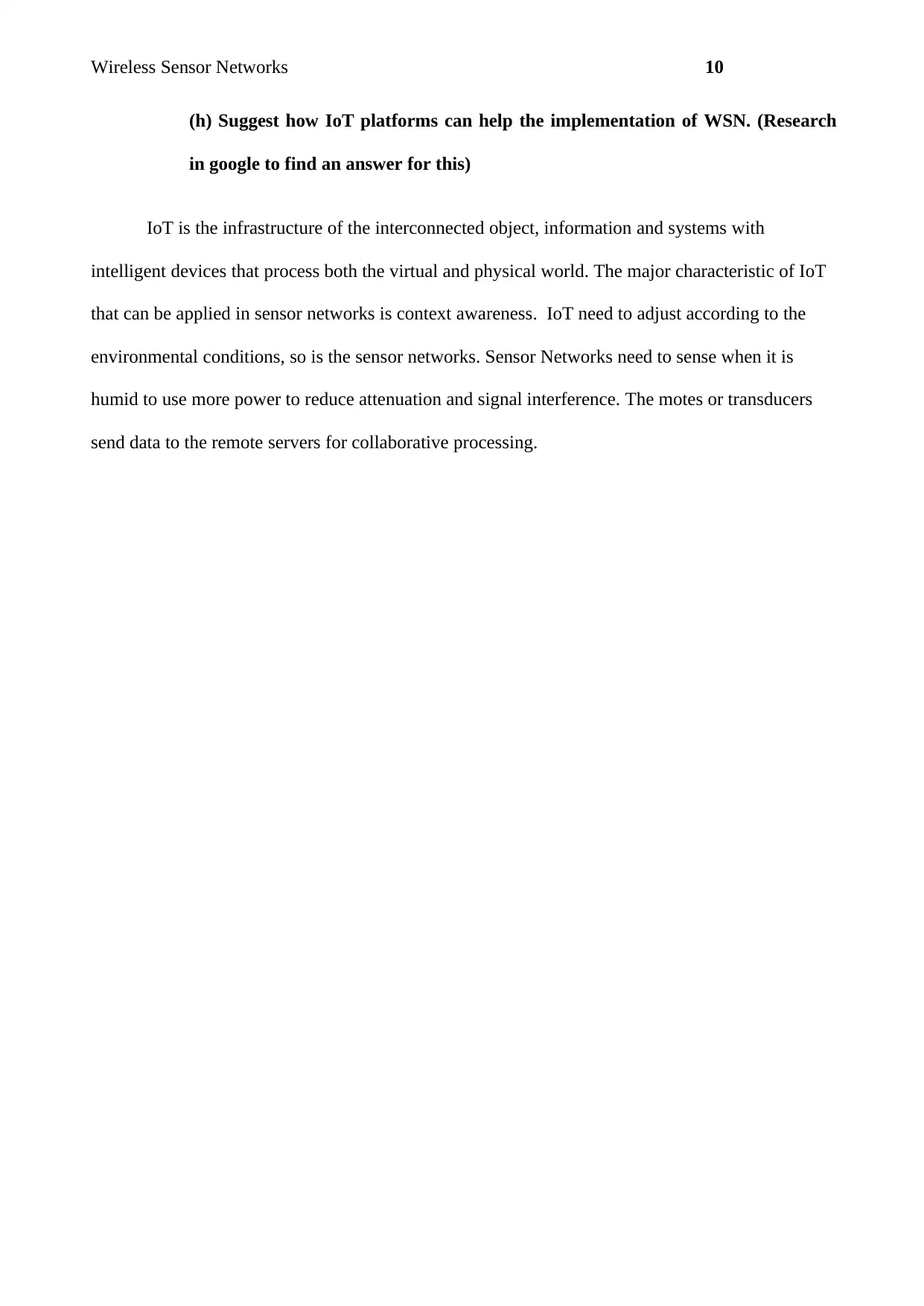
Wireless Sensor Networks 10
(h) Suggest how IoT platforms can help the implementation of WSN. (Research
in google to find an answer for this)
IoT is the infrastructure of the interconnected object, information and systems with
intelligent devices that process both the virtual and physical world. The major characteristic of IoT
that can be applied in sensor networks is context awareness. IoT need to adjust according to the
environmental conditions, so is the sensor networks. Sensor Networks need to sense when it is
humid to use more power to reduce attenuation and signal interference. The motes or transducers
send data to the remote servers for collaborative processing.
(h) Suggest how IoT platforms can help the implementation of WSN. (Research
in google to find an answer for this)
IoT is the infrastructure of the interconnected object, information and systems with
intelligent devices that process both the virtual and physical world. The major characteristic of IoT
that can be applied in sensor networks is context awareness. IoT need to adjust according to the
environmental conditions, so is the sensor networks. Sensor Networks need to sense when it is
humid to use more power to reduce attenuation and signal interference. The motes or transducers
send data to the remote servers for collaborative processing.
Paraphrase This Document
Need a fresh take? Get an instant paraphrase of this document with our AI Paraphraser
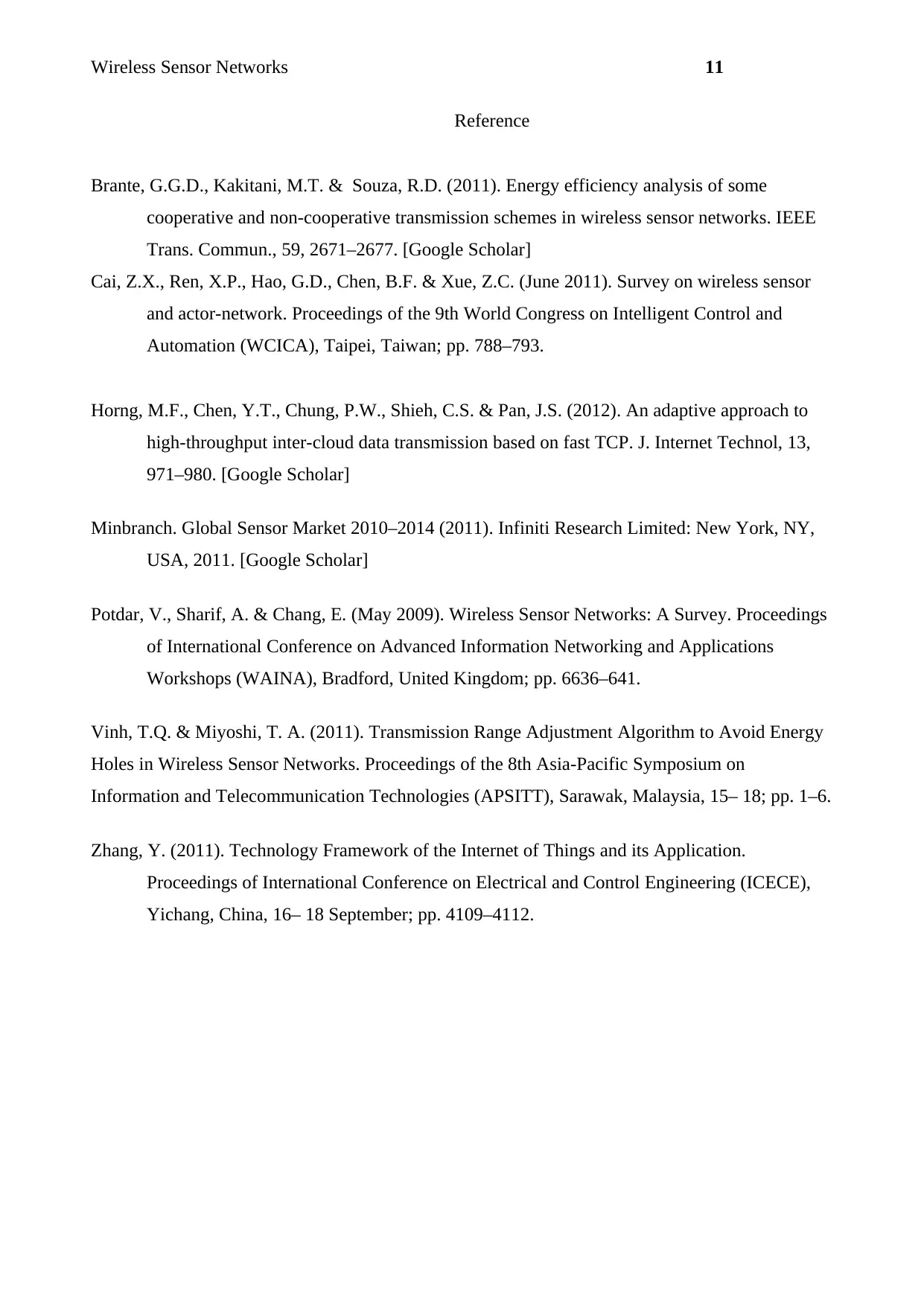
Wireless Sensor Networks 11
Reference
Brante, G.G.D., Kakitani, M.T. & Souza, R.D. (2011). Energy efficiency analysis of some
cooperative and non-cooperative transmission schemes in wireless sensor networks. IEEE
Trans. Commun., 59, 2671–2677. [Google Scholar]
Cai, Z.X., Ren, X.P., Hao, G.D., Chen, B.F. & Xue, Z.C. (June 2011). Survey on wireless sensor
and actor-network. Proceedings of the 9th World Congress on Intelligent Control and
Automation (WCICA), Taipei, Taiwan; pp. 788–793.
Horng, M.F., Chen, Y.T., Chung, P.W., Shieh, C.S. & Pan, J.S. (2012). An adaptive approach to
high-throughput inter-cloud data transmission based on fast TCP. J. Internet Technol, 13,
971–980. [Google Scholar]
Minbranch. Global Sensor Market 2010–2014 (2011). Infiniti Research Limited: New York, NY,
USA, 2011. [Google Scholar]
Potdar, V., Sharif, A. & Chang, E. (May 2009). Wireless Sensor Networks: A Survey. Proceedings
of International Conference on Advanced Information Networking and Applications
Workshops (WAINA), Bradford, United Kingdom; pp. 6636–641.
Vinh, T.Q. & Miyoshi, T. A. (2011). Transmission Range Adjustment Algorithm to Avoid Energy
Holes in Wireless Sensor Networks. Proceedings of the 8th Asia-Pacific Symposium on
Information and Telecommunication Technologies (APSITT), Sarawak, Malaysia, 15– 18; pp. 1–6.
Zhang, Y. (2011). Technology Framework of the Internet of Things and its Application.
Proceedings of International Conference on Electrical and Control Engineering (ICECE),
Yichang, China, 16– 18 September; pp. 4109–4112.
Reference
Brante, G.G.D., Kakitani, M.T. & Souza, R.D. (2011). Energy efficiency analysis of some
cooperative and non-cooperative transmission schemes in wireless sensor networks. IEEE
Trans. Commun., 59, 2671–2677. [Google Scholar]
Cai, Z.X., Ren, X.P., Hao, G.D., Chen, B.F. & Xue, Z.C. (June 2011). Survey on wireless sensor
and actor-network. Proceedings of the 9th World Congress on Intelligent Control and
Automation (WCICA), Taipei, Taiwan; pp. 788–793.
Horng, M.F., Chen, Y.T., Chung, P.W., Shieh, C.S. & Pan, J.S. (2012). An adaptive approach to
high-throughput inter-cloud data transmission based on fast TCP. J. Internet Technol, 13,
971–980. [Google Scholar]
Minbranch. Global Sensor Market 2010–2014 (2011). Infiniti Research Limited: New York, NY,
USA, 2011. [Google Scholar]
Potdar, V., Sharif, A. & Chang, E. (May 2009). Wireless Sensor Networks: A Survey. Proceedings
of International Conference on Advanced Information Networking and Applications
Workshops (WAINA), Bradford, United Kingdom; pp. 6636–641.
Vinh, T.Q. & Miyoshi, T. A. (2011). Transmission Range Adjustment Algorithm to Avoid Energy
Holes in Wireless Sensor Networks. Proceedings of the 8th Asia-Pacific Symposium on
Information and Telecommunication Technologies (APSITT), Sarawak, Malaysia, 15– 18; pp. 1–6.
Zhang, Y. (2011). Technology Framework of the Internet of Things and its Application.
Proceedings of International Conference on Electrical and Control Engineering (ICECE),
Yichang, China, 16– 18 September; pp. 4109–4112.
1 out of 11
Related Documents
Your All-in-One AI-Powered Toolkit for Academic Success.
+13062052269
info@desklib.com
Available 24*7 on WhatsApp / Email
![[object Object]](/_next/static/media/star-bottom.7253800d.svg)
Unlock your academic potential
Copyright © 2020–2025 A2Z Services. All Rights Reserved. Developed and managed by ZUCOL.

